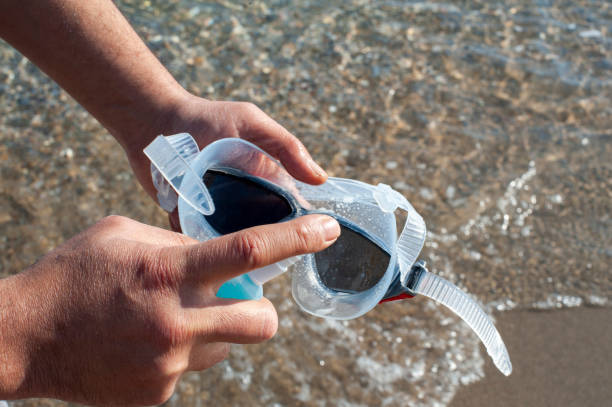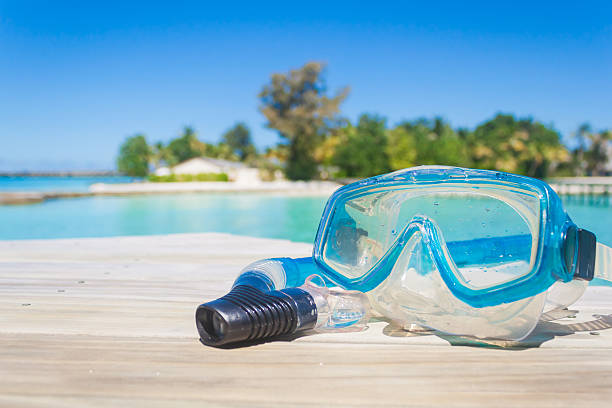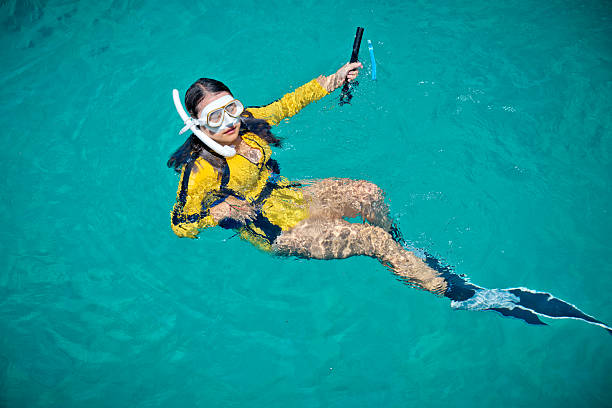Le maschere integrali da snorkeling hanno guadagnato popolarità, offrendo un'allettante combinazione di praticità e migliore visibilità subacquea. Con la crescita della loro presenza sul mercato, aumentano anche le domande sulla loro sicurezza. Questo articolo approfondisce la sicurezza delle maschere integrali da snorkeling e i loro intricati dettagli, con l'obiettivo di svelarne le caratteristiche e i potenziali rischi, fornendo al contempo una guida completa per gli appassionati di snorkeling.
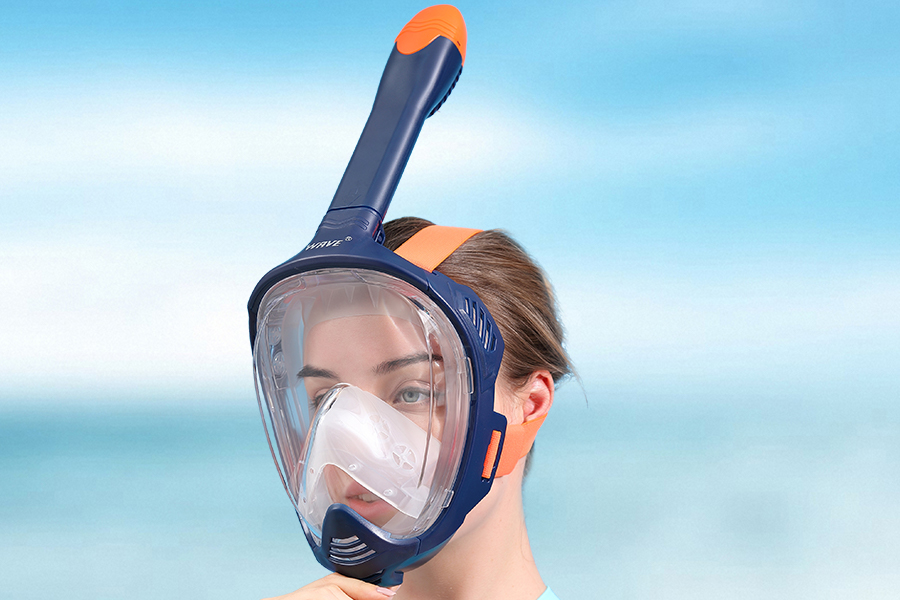
Possiamo usare le maschere integrali da snorkeling? La risposta è sì, ed ecco perché.
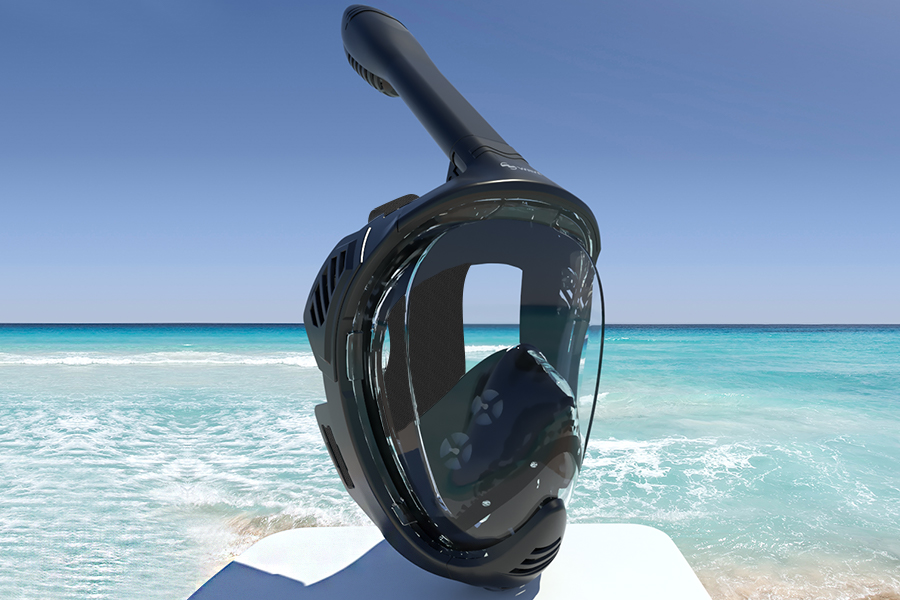
Maschere da snorkeling integrali Rappresentano un significativo passo avanti rispetto alle maschere e agli snorkel tradizionali. Sono progettati per coprire l'intero viso, integrando il tubo respiratorio all'interno della maschera stessa. Questo design consente agli utenti di respirare naturalmente attraverso naso e bocca, offrendo un'esperienza più confortevole e meno claustrofobica.
A differenza dei tradizionali set da snorkeling in cui maschera e boccaglio sono separati, le maschere integrali li combinano entrambi, eliminando la necessità di stringere il boccaglio dello snorkel tra i denti.
Inoltre, vanno oltre il comfort. Offrono una vista panoramica, migliorando l'esperienza subacquea e consentendo agli amanti dello snorkeling di vedere più lontano possibile senza dover girare la testa. Queste maschere spesso includono sistemi dry-top integrati, che impediscono all'acqua di entrare nello snorkel quando si è immersi. Le maschere tradizionali, al contrario, richiedono spesso di padroneggiare la tecnica di svuotamento dell'acqua dallo snorkel. Le maschere granfacciali semplificano questa operazione, rendendole particolarmente adatte ai principianti.
Problemi di sicurezza comuni che preoccupano le persone
Nonostante i loro numerosi vantaggi, le maschere integrali da snorkeling hanno sollevato preoccupazioni in termini di sicurezza sia tra gli utenti che tra gli esperti. Comprendere questi aspetti è fondamentale per prendere una decisione consapevole.
Rischio di accumulo di CO2
Una delle principali preoccupazioni relative alle maschere integrali da snorkeling è il rischio di accumulo di anidride carbonica (CO2). Il design di queste maschere può potenzialmente creare sacche in cui la CO2 espirata rimane, causando una reinalazione. Questo può causare sintomi come vertigini, disorientamento e, in casi estremi, perdita di coscienza. Per mitigare questo rischio, i produttori hanno sviluppato sistemi di ventilazione innovativi che promuovono un'efficiente circolazione dell'aria. Assicurarsi che la maschera sia dotata di canali di ventilazione adeguati e utilizzarla come indicato è fondamentale per ridurre al minimo questo pericolo.
Potenziale di difficoltà respiratorie
Respirare naturalmente sia attraverso il naso che la bocca può essere un'arma a doppio taglio. Pur offrendo comfort, può anche causare difficoltà respiratorie se la maschera non è progettata correttamente. Maschere mal costruite possono creare resistenza, rendendo difficile inspirare ed espirare fluidamente. Gli utenti dovrebbero cercare maschere con sistemi di flusso d'aria efficienti e valutare la possibilità di provare diversi modelli per trovare la vestibilità migliore. Si consiglia inoltre di fare pause regolari e di non sforzarsi eccessivamente durante lo snorkeling per prevenire problemi respiratori.
Problemi di visibilità e campo visivo
Un altro problema è la visibilità. Sebbene le maschere integrali offrano una visione panoramica, il design a volte può causare appannamento, ostruendo il campo visivo. Le maschere di alta qualità sono in genere dotate di rivestimenti o sistemi antiappannamento per risolvere questo problema. Gli utenti possono anche applicare soluzioni antiappannamento o assicurarsi di pulirle correttamente prima dell'uso. Assicurarsi che la maschera aderisca bene e sia correttamente regolata può anche contribuire a mantenere una visibilità ottimale.
Come valutare correttamente le sue caratteristiche di sicurezza?
Per garantire un'esperienza di snorkeling sicura e piacevole è essenziale valutare le caratteristiche di sicurezza di una maschera integrale.
Valutare il design anti-perdita
Un design anti-perdita affidabile è fondamentale per un'esperienza di snorkeling confortevole e sicura. Quando si valuta una maschera, è opportuno dare priorità a quelle con facciale in silicone di alta qualità, in quanto offrono una vestibilità flessibile e aderente al viso, prevenendo efficacemente le perdite. Verificare che la tasca nasale sia ben progettata, per consentire una facile compensazione e garantire una buona tenuta. Anche i cinturini regolabili sono importanti per garantire che la maschera aderisca saldamente senza essere troppo stretta. Prima di immergersi in acque più profonde, testare la maschera in zone poco profonde per verificare che mantenga una tenuta stagna e non si appanni facilmente. Questo approccio proattivo garantisce un'avventura di snorkeling più piacevole e senza intoppi.
Valutare il sistema Dry Top integrato
Il sistema Dry Top integrato è un'altra caratteristica di sicurezza fondamentale. Questo meccanismo impedisce all'acqua di entrare nel boccaglio quando è immerso, riducendo il rischio di inalazione. Verificare che il sistema Dry Top funzioni correttamente e che si chiuda automaticamente quando lo snorkel è immerso.
Valutare la copertura e la protezione del viso completo
La copertura integrale del viso offre una protezione completa, riparando il viso dall'acqua e consentendo una respirazione libera. Tuttavia, è fondamentale assicurarsi che la maschera non prema eccessivamente sul viso, il che può causare fastidio e impedire la respirazione. La maschera deve essere comoda, senza punti di pressione.
Ricerche e studi reali sulla sicurezza
Studi scientifici forniscono preziose informazioni sulla sicurezza delle maschere integrali da snorkeling, indirizzando i consumatori verso scelte più sicure.
Analisi dei risultati e dei risultati dei test
Studi recenti hanno testato vari modelli di maschere integrali da snorkeling, concentrandosi su fattori quali l'accumulo di CO2, la resistenza al flusso d'aria e la sicurezza generale.
In uno studio completo condotto da DAN (Divers Alert Network), i ricercatori hanno analizzato diverse maschere integrali da snorkeling di diversi produttori. Lo studio ha rivelato che alcuni modelli presentavano livelli di ritenzione di CO2 significativamente superiori a quelli riscontrati in maschere e boccagli tradizionali. Ad esempio, una maschera testata ha mostrato livelli di CO2 fino a 4,5%, mentre la soglia di sicurezza accettabile per la ritenzione di CO2 è in genere inferiore a 1%. Livelli elevati di CO2 possono portare a ipercapnia, che causa sintomi come vertigini, mal di testa e, nei casi più gravi, perdita di coscienza.
Un altro studio condotto da Consumer Reports in collaborazione con un laboratorio di analisi europeo ha esaminato la resistenza al flusso d'aria in diverse maschere integrali da snorkeling. I risultati hanno indicato che, sebbene molte maschere fornissero una ventilazione adeguata, alcuni modelli presentavano un flusso d'aria insufficiente, rendendo la respirazione più faticosa e aumentando il rischio di disagio o panico sott'acqua. Ad esempio, è stato riscontrato che un particolare modello di maschera presentava una resistenza al flusso d'aria di 35% superiore a quella dei tradizionali set da snorkeling, il che può causare difficoltà respiratorie soprattutto durante il nuoto intenso.
Questi risultati sottolineano l'importanza di scegliere mascherine di produttori affidabili che rispettino rigorosi standard di sicurezza. Modelli di marchi noti come Avanguardia, Tribord, Ocean Reef e Seaview hanno ottenuto risultati significativamente migliori in termini di livelli di CO2 ed efficienza del flusso d'aria rispetto ad alternative più economiche e non di marca. La maschera Tribord Easybreath, ad esempio, ha mostrato livelli di ritenzione di CO2 costantemente inferiori a 0,7%, ben al di sotto dei limiti di sicurezza, e ha mostrato una minima resistenza al flusso d'aria.
Pareri e raccomandazioni degli esperti
Esperti nel campo delle immersioni e dello snorkeling si sono espressi sulla sicurezza delle maschere integrali da snorkeling. Molti consigliano di optare per maschere che siano state sottoposte a rigorosi test e certificazioni. Il Dott. Neal W. Pollock, direttore di ricerca presso DAN, consiglia agli amanti dello snorkeling di diffidare delle maschere generiche e non testate, spesso vendute online. Sottolinea l'importanza di acquistare maschere con certificazioni di sicurezza chiare, come il marchio CE, che attesta la conformità agli standard europei in materia di salute, sicurezza e tutela ambientale.
Inoltre, gli esperti raccomandano pause frequenti durante lo snorkeling per prevenire sforzi eccessivi e il potenziale accumulo di CO2. Sottolineano inoltre la necessità di una corretta manutenzione e di ispezioni regolari delle maschere per garantirne il corretto funzionamento. Semplici accorgimenti, come la pulizia della maschera dopo ogni utilizzo e il controllo di eventuali segni di usura o danni, possono migliorare significativamente la sicurezza.
Esperienze degli utenti e testimonianze sulle maschere integrali da snorkeling
Il feedback degli utenti fornisce informazioni preziose sulle prestazioni e la sicurezza delle maschere integrali da snorkeling. Analizziamo alcuni esempi concreti relativi a diversi aspetti dell'esperienza utente.
Feedback positivo dagli utenti
Molti utenti hanno condiviso esperienze positive con le maschere integrali da snorkeling, sottolineandone la comodità, la praticità e la migliore visibilità subacquea.
Aspetto positivo: comfort e facilità di respirazione
“Uso la maschera Seaview 180° da oltre un anno e ha trasformato completamente la mia esperienza di snorkeling. La maschera calza perfettamente ed è incredibilmente comoda sul viso. Respirare sia con il naso che con la bocca è del tutto naturale e adoro il fatto di non dovermi mai preoccupare che l'acqua entri nel boccaglio. Ha reso lo snorkeling molto più piacevole!” – Alex, appassionato di snorkeling dalle Hawaii
Aspetto positivo: vista panoramica
Ho provato di recente la maschera Ocean Reef Aria durante un'uscita di snorkeling nei Caraibi e sono rimasta sbalordita dalla vista panoramica che offriva. Le lenti nitide e ampie mi hanno permesso di vedere molto di più sott'acqua e mi sono sentita parte integrante dell'oceano. È senza dubbio la migliore maschera che abbia mai usato! – Sarah, un'appassionata amante dell'oceano dalla Florida
Reclami e problemi comuni segnalati
Sebbene le maschere integrali da snorkeling abbiano ricevuto elogi da molti utenti, alcuni di loro hanno anche segnalato reclami e problemi comuni.
Problema segnalato: appannamento
Ho acquistato una maschera integrale da snorkeling di un marchio meno noto, sperando in un'esperienza di snorkeling comoda e piacevole. Tuttavia, sono rimasto deluso nello scoprire che si appannava costantemente, ostruendomi la visuale e rovinando l'esperienza. Nonostante abbia provato soluzioni antiappannamento, il problema persisteva e alla fine sono tornato alla mia maschera tradizionale. – Mark, uno snorkelista frustrato della California
Problema segnalato: perdite
Ho provato la maschera Tribord Easybreath durante un'escursione di snorkeling in Messico e, pur apprezzandone il comfort e l'ampio campo visivo, ho riscontrato notevoli perdite intorno alla guarnizione. Non importava quanto stringessi i cinghioli, l'acqua penetrava nella maschera, causando continue interruzioni e fastidio. È stata un'esperienza deludente, soprattutto considerando le recensioni positive che avevo letto. – Jessica, appassionata di snorkeling dal Texas
Incidenti e infortuni nella vita reale
Sebbene rari, si sono verificati casi reali di incidenti e infortuni associati alle maschere integrali da snorkeling, il che evidenzia l'importanza delle precauzioni di sicurezza e del loro corretto utilizzo.
Incidente: accumulo di CO2
Durante un'uscita di snorkeling alle Bahamas, ho iniziato a sentirmi stordito e disorientato mentre usavo una maschera integrale. Inizialmente l'ho attribuito allo sforzo, ma una volta tornato in superficie, mi sono reso conto di avere sintomi di accumulo di CO2. È stata un'esperienza spaventosa, ho subito tolto la maschera e ho consultato un medico. Da allora, sono diventato più cauto e selettivo riguardo alle maschere che uso. – David, subacqueo esperto di New York
Incidente: malfunzionamento della maschera
Mentre faceva snorkeling in Thailandia, la mia amica ha avuto un incidente spaventoso con la sua maschera integrale. Improvvisamente, il sistema di chiusura a secco della maschera si è rotto, permettendo all'acqua di entrare nel boccaglio. In preda al panico e incapace di respirare, si è tolta rapidamente la maschera ed è riemersa. Fortunatamente, è rimasta illesa, ma è stato un duro promemoria dell'importanza dell'affidabilità e della sicurezza dell'attrezzatura. – Rachel, viaggiatrice d'avventura dall'Australia
Questi esempi concreti sottolineano la necessità di una valutazione approfondita e di cautela nell'uso delle maschere integrali da snorkeling. Sebbene offrano numerosi vantaggi, è fondamentale che gli utenti siano consapevoli dei potenziali problemi e diano sempre priorità alla sicurezza.
Consigli per lo snorkeling sicuro con maschere integrali
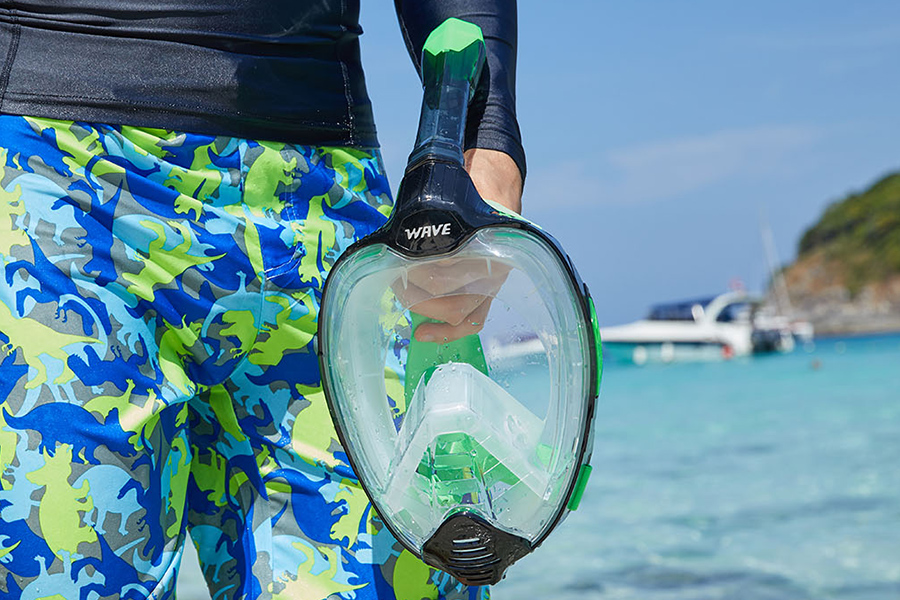
Un'esperienza di snorkeling sicura con la maschera integrale richiede un'adeguata preparazione e il rispetto delle migliori pratiche. Seguendo le istruzioni corrette, puoi massimizzare la sicurezza e il divertimento mentre esplori le meraviglie del mondo sottomarino con la tua maschera integrale da snorkeling. Vediamo alcuni consigli essenziali su diversi aspetti.
Montaggio e regolazione corretti
Prima di immergerti, prenditi il tempo di regolare i cinturini della maschera per ottenere una vestibilità aderente e sicura. Assicurati che la maschera aderisca comodamente al viso senza creare punti di pressione o fessure. Una maschera ben aderente garantisce una tenuta stagna, prevenendo perdite e riducendo al minimo il rischio di infiltrazioni d'acqua nel boccaglio.
Suggerimenti per evitare problemi comuni
Per prevenire l'appannamento, applicare un sottile strato di soluzione antiappannamento all'interno delle lenti della maschera prima di ogni utilizzo. Inoltre, assicurarsi che la maschera sia pulita e asciutta prima di applicare la soluzione per un'efficacia ottimale. Seguire questi semplici accorgimenti può aiutare a mantenere una visibilità ottimale sott'acqua e a migliorare la propria esperienza di snorkeling.
Le migliori pratiche per i principianti
Inizia la tua esperienza di snorkeling in acque basse e calme, dove potrai esercitarti con maschera e boccaglio in un ambiente controllato. Fai respiri lenti e costanti e concentrati sul mantenere una postura rilassata e confortevole in acqua. Aumenta gradualmente la profondità ed esplora nuovi luoghi man mano che acquisisci sicurezza e competenza nelle tecniche di snorkeling.
Come migliorare il livello di sicurezza? Linee guida e istruzioni del produttore
I produttori forniscono linee guida e istruzioni essenziali per migliorare la sicurezza delle maschere integrali da snorkeling. Approfondiamo diversi aspetti e dettagli concreti per garantirne un utilizzo sicuro.
Istruzioni per l'uso corretto
I produttori in genere raccomandano di familiarizzare con le caratteristiche e le funzioni della maschera prima dell'uso. Questo include imparare come regolare i cinturini per una vestibilità sicura, come svuotare la maschera in caso di infiltrazioni d'acqua e come utilizzare eventuali funzioni aggiuntive come il sistema dry top. Inoltre, si consiglia agli utenti di esercitarsi a respirare attraverso la maschera in un ambiente controllato prima di avventurarsi in acque più profonde.
Nota*: Assicuratevi di leggere attentamente e comprendere il manuale d'uso fornito dal produttore. Prestate particolare attenzione a eventuali istruzioni o precauzioni specifiche, come i limiti di profondità consigliati o gli intervalli di temperatura dell'acqua, per evitare potenziali rischi o danni alla maschera.
Suggerimenti per la manutenzione e la pulizia
I produttori raccomandano in genere di sciacquare la mascherina con acqua dolce dopo ogni utilizzo per rimuovere sale, sabbia e altri detriti che potrebbero accumularsi. È inoltre importante asciugare accuratamente la mascherina prima di riporla in un luogo fresco e asciutto, lontano dalla luce solare diretta. Inoltre, alcune mascherine potrebbero richiedere una pulizia periodica con acqua e sapone delicato per rimuovere eventuali residui o accumuli.
Nota*: Evitate l'uso di prodotti chimici aggressivi o detergenti abrasivi, poiché possono danneggiare i materiali della mascherina e comprometterne l'integrità. Seguite attentamente le istruzioni di pulizia del produttore per preservare la qualità e la funzionalità della mascherina nel tempo.
Avvertenze e raccomandazioni di sicurezza del produttore
Le avvertenze di sicurezza più comuni possono includere promemoria per non fare mai snorkeling da soli, per rimanere entro i limiti di profondità raccomandati e per evitare movimenti bruschi o attività faticose mentre si indossa la maschera. I produttori possono anche fornire raccomandazioni per ispezionare la maschera per verificare la presenza di segni di usura o danni prima di ogni utilizzo, nonché indicazioni su quando sostituire determinati componenti, come guarnizioni o cinturini in silicone.
Nota*: Prendi sul serio le avvertenze di sicurezza del produttore e incorporale nelle tue pratiche di snorkeling per ridurre al minimo il rischio di incidenti o lesioni. Dai sempre priorità alla sicurezza e fai attenzione quando utilizzi la maschera integrale in condizioni non familiari o difficili.
Standard normativi e certificazioni
Produttori affidabili come Vanguard sottopongono spesso le loro maschere integrali da snorkeling a rigorosi test e certificazioni per garantire che soddisfino o superino gli standard di sicurezza stabiliti. Cercate certificazioni come la marcatura CE, che indica la conformità agli standard europei in materia di salute, sicurezza e tutela ambientale. Inoltre, alcuni produttori potrebbero sottoporsi volontariamente a test da parte di organizzazioni indipendenti o enti regolatori per convalidare la sicurezza e le prestazioni delle loro maschere.
Conclusione
In conclusione, la domanda "Quanto sono sicure le maschere integrali da snorkeling?" richiede un'attenta riflessione, ma queste possono offrire un'esperienza di snorkeling sicura e piacevole con un utilizzo e una manutenzione adeguati e il rispetto delle linee guida del produttore. Seguendo le migliori pratiche, come la corretta vestibilità, la manutenzione regolare e il rispetto delle avvertenze di sicurezza, gli amanti dello snorkeling possono mitigare i potenziali rischi e massimizzare i benefici di queste maschere innovative. Nonostante le preoccupazioni, un processo decisionale consapevole, abbinato a maschere affidabili di produttori affidabili, può migliorare significativamente i livelli di sicurezza. In definitiva, con la dovuta attenzione e un uso responsabile, le maschere integrali da snorkeling possono offrire un accesso sicuro all'esplorazione delle meraviglie del mondo sottomarino.
Domande frequenti
D1: Per quanto tempo è possibile respirare con una maschera integrale da snorkeling?
In media, gli utenti possono aspettarsi di respirare comodamente con una maschera integrale per circa 1-2 ore, assumendo una normale attività di snorkeling e uno sforzo moderato. Tuttavia, fattori individuali come la capacità polmonare e il livello di forma fisica possono influenzare questa durata.
D2: Come si fa ad andare sott'acqua con una maschera integrale da snorkeling?
Per immergersi con una maschera integrale da snorkeling, basta fare un respiro profondo, trattenere il respiro e immergersi sotto la superficie dell'acqua. Assicurarsi che la maschera sia ben aderente al viso per evitare l'ingresso di acqua. Una volta sott'acqua, espirare delicatamente dal naso per compensare la pressione e godersi il panorama subacqueo.
D3: Gli snorkel integrali vanno bene per i bambini?
Le maschere integrali da snorkeling possono essere adatte ai bambini, ma è necessario considerare diversi fattori prima di consentire loro di utilizzarne una. Dimensioni e caratteristiche appropriate garantiscono una vestibilità adeguata e un'esperienza d'uso confortevole. Inoltre, i bambini devono essere attentamente sorvegliati durante l'utilizzo delle maschere integrali da snorkeling, soprattutto se sono nuotatori inesperti o alle prime armi con lo snorkeling. I genitori devono anche assicurarsi che i propri figli capiscano come utilizzare correttamente la maschera, incluso come eliminare l'acqua dal boccaglio e dalla superficie, se necessario.
D4: Gli snorkel integrali sono davvero migliori delle maschere tradizionali?
La scelta tra maschere integrali da snorkeling e maschere tradizionali dipende dalle preferenze e dalle esigenze individuali. Le maschere integrali offrono un campo visivo più ampio, una respirazione più facile attraverso naso e bocca e possono essere più comode per alcuni utenti. Tuttavia, le maschere tradizionali offrono maggiore flessibilità, sono spesso più compatte per i viaggi e consentono di svuotare più facilmente lo snorkel dall'acqua. In definitiva, la scelta tra le due dipende da fattori come il comfort, la facilità d'uso e le preferenze personali.
D5: Le maschere integrali da snorkeling sollevano problemi di sicurezza?
Sì, le maschere integrali da snorkeling possono sollevare problemi di sicurezza, in particolare per quanto riguarda l'accumulo di CO2, le difficoltà respiratorie e il rischio di perdite. Maschere non correttamente indossate o dotate di sistemi di ventilazione inadeguati possono comportare rischi come la ritenzione di CO2, che può causare vertigini o perdita di coscienza. Inoltre, gli utenti potrebbero riscontrare difficoltà respiratorie se la maschera limita il flusso d'aria. Un utilizzo corretto, il rispetto delle linee guida del produttore e la scelta di maschere di alta qualità possono contribuire ad attenuare questi problemi.
D6: Le maschere integrali da snorkeling perdono acqua?
Le maschere da snorkeling integrali possono potenzialmente presentare perdite se non sono indossate correttamente o se le guarnizioni lungo i bordi sono compromesse. Tuttavia, le maschere di alta qualità con meccanismi di tenuta efficaci sono progettate per ridurre al minimo le perdite. È essenziale assicurarsi che la maschera sia regolata correttamente per aderire perfettamente al viso e che i cinturini siano ben stretti per impedire l'ingresso di acqua. Anche una manutenzione e un'ispezione regolari delle guarnizioni della maschera possono contribuire a prevenire le perdite durante le sessioni di snorkeling.
D7: Perché non è possibile indossare maschere da snorkeling in piscina?
Le maschere da snorkeling non sono generalmente consigliate per l'uso in piscina perché il design della maschera, in particolare del boccaglio, è progettato per l'uso in acque libere come oceani, laghi o fiumi. In piscina, il boccaglio potrebbe non funzionare efficacemente a causa della mancanza di onde o correnti che creino un flusso d'aria naturale. Inoltre, il design della maschera potrebbe ostacolare le tecniche di nuoto corrette, rendendo difficile la navigazione e aumentando potenzialmente il rischio di incidenti o collisioni con altri nuotatori.
